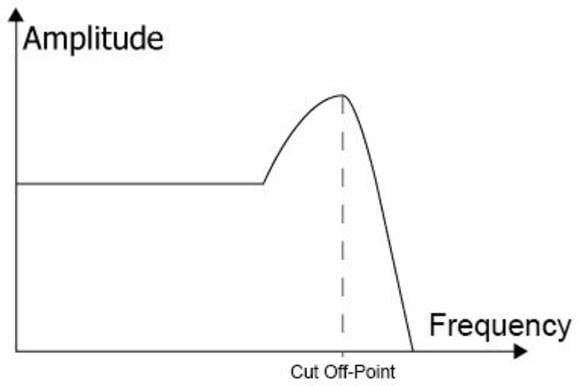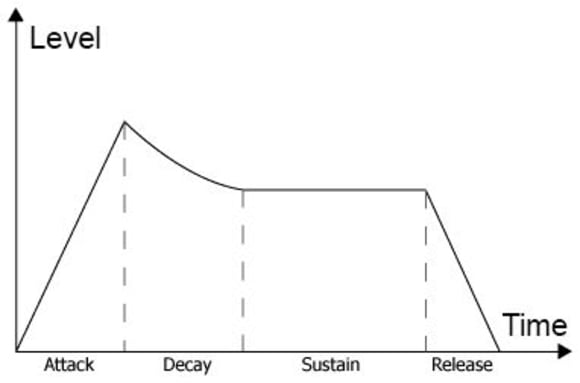3. Subtractive Synthesizer
In its simplest form, three main sections are incorporated - an oscillator, filter and amplifier. The oscillator generates the basic sound, usually a sine, pulse or sawtooth wave; the filter contours the frequency spectrum of the wave from the oscillator; and the amplifier controls the volume of the generated and filtered waveform over time - it's envelope. Note that the horizontal lines in the diagram below indicate the path of the sound itself - the vertical lines indicate control signals. The envelope for example only modulates (controls) the amplifier it does not affect the sound directly.

We'll now look at each section in turn, starting with the oscillators, as this is where the sound originates. As they produce the basic building block of the sound, some method is necessary to control their pitch from a keyboard. In the analogue world, this is done by means of control voltages (hence the label Voltage Controlled Oscillator or VCO), and the most common approach was the so-called 'one volt per octave' system. The keyboard is arranged so that whenever a key is depressed, an electrical voltage is produced, which in effect is used to tune the oscillator to the required note.
The raw oscillator sound can usually take the form of one of a number of different waveshapes, to allow you to choose from a range of basic timbres appropriate to the sound you might want to achieve. Each waveform has its own characteristic spectrum by which it can be identified:
Sawtooth
Sawtooth - sometimes known simply as Saw, it contains all harmonics, odd and even, in proportional values, and because of this, it sounds rich and buzzy. The high harmonics have a relatively large amplitude which gives the waveform its characteristically bright sound.
Pulse
The Pulse wave is a rectangular waveform, usually with the ability to have the ratio of the length of its positive cycle to its negative cycle (or its width) varied by an LFO (see below). Where the width is at its narrowest, it sounds thin and nasal, and this is sometimes called the duty cycle. Where the width is equal on each cycle, it is also known as a square wave:
Square
A special type of pulse wave because it contains only odd (and no even) harmonics or partials, and as a result has a hollow sound, not entirely dissimilar to a clarinet. The harmonics decrease in amplitude with frequency.
Sine
A sine wave contains only the base or fundamental frequency, and no harmonics, which is why it sounds pure or simple. It is difficult to do much to change the sound of a sine wave!
Noise
Noise - or more precisely white noise, which is the type most commonly found on synthesizers, contains all frequencies continuously randomly changing. It has no harmonics or partials, since the frequencies are not even multiples of each other. It also has no base frequency or fundamental. Pink noise has less high frequency content than white noise, while brown noise has less still.
Sync
Most multi-oscillator synths feature a sync function, usually on the second oscillator. This forces the oscillator being modulated (usually the first) to restart its waveform from zero every time the modulating oscillator completes one cycle. As a result, when you change the frequency of the modulated oscillator, rather than changing the pitch, it changes the timbre, producing a characteristic metallic sound.
Filter
The filter is generally considered to be the most important part of any synthesizer, almost regardless of the type of synthesis used, as it is the parameter that affects the sound most drastically. Filters come in many different forms - the most common classification method is based on the shape of the attenuation curve. If a sine wave of a given frequency is fed through a filter, then the output represents the attenuation of the filter at that frequency. When measured at multiple frequencies and plotted on a graph, this is called the frequency response curve of the filter. The most common types of filter curves are low-pass (cuts high frequencies and lets low frequencies pass the most common of all); high-pass (cuts low frequencies and lets high frequencies pass); band-pass (cuts high and low frequencies and lets the mid pass); and notch (cuts a very narrow band of frequencies).
The point at which the filter begins to affect the signal is called the cut-off point, and this is usually the filter's main control on a synthesizer. The steepness of the cut-off slope also has a strong effect on the sound - most current analogue synths (or models thereof) have 12 or 24dB/octave filters, which is achieved by cascading a number of simpler 6dB filters together to produce a steeper slope. Each of these filters is also known as a pole - a 24dB/octave filter is often called a 4 pole filter.
The last important aspect of a filter is its resonance control increasing resonance emphasises a very narrow band of frequencies around the cut-off point, and creates the wow sound that is characteristic of a subtractive synthesizer. At extreme settings, some filters go into self oscillation, which produces a distinct sine wave-like tone around the cutoff frequency.
Envelope

Envelope - the term used to describe the shape of the volume of a sound over time. Most synthesizers provide an envelope generator which modulates the amplifier to control the envelope its parameters are commonly split into segments called Attack, Decay, Sustain and Release. The time from silence to the initial loudest point is the Attack, while the time for the envelope to decrease after this to a steady value is the Decay. The sound then continues at a level known as Sustain, and remains at this level as long as the key is held down. Once the key is released, the sound resumes its decay, this time at a rate determined by the Release setting. It is important to note that while Attack, Decay and Release control the rate at which the envelope settings change, the Sustain parameter is a level. Once the idea of envelope generators had been thought of, it was realised that they could also be used to modulate other aspects of synthesis such as filter cutoff, and so most subtractive synthesizers offer at least two.
LFO Low Frequency Oscillator
LFO - a Low Frequency Oscillator - , used not to produce sound (its frequency range would be too low to hear!), but like envelope generators, as a control signal. The most common use is to modulate the pitch of an oscillator to produce a vibrato effect, but it can also be used to modulate the amplifier for tremolo, or the filter, for instance synchronised to MIDI clock to produce long filter sweeps in time with the music. Like regular oscillators, LFOs can have many different wave shapes.





